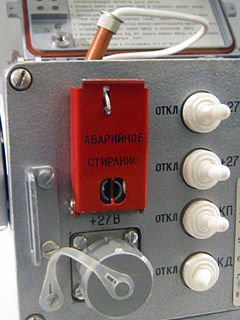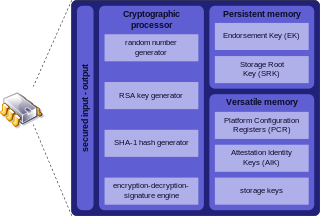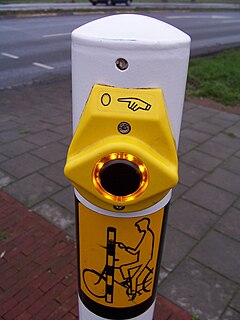
Authentication is the act of confirming the truth of an attribute of a single piece of data claimed true by an entity. In contrast with identification, which refers to the act of stating or otherwise indicating a claim purportedly attesting to a person or thing's identity, authentication is the process of actually confirming that identity. It might involve confirming the identity of a person by validating their identity documents, verifying the authenticity of a website with a digital certificate, determining the age of an artifact by carbon dating, or ensuring that a product is what its packaging and labeling claim to be. In other words, authentication often involves verifying the validity of at least one form of identification.
Trusted Computing (TC) is a technology developed and promoted by the Trusted Computing Group. The term is taken from the field of trusted systems and has a specialized meaning. With Trusted Computing, the computer will consistently behave in expected ways, and those behaviors will be enforced by computer hardware and software. Enforcing this behavior is achieved by loading the hardware with a unique encryption key inaccessible to the rest of the system.

A secure cryptoprocessor is a dedicated computer on a chip or microprocessor for carrying out cryptographic operations, embedded in a packaging with multiple physical security measures, which give it a degree of tamper resistance. Unlike cryptographic processors that output decrypted data onto a bus in a secure environment, a secure cryptoprocessor does not output decrypted data or decrypted program instructions in an environment where security cannot always be maintained.

A smart card, chip card, or integrated circuit card (ICC) is a physical electronic authorization device, used to control access to a resource. It is typically a plastic credit card sized card with an embedded integrated circuit. Many smart cards include a pattern of metal contacts to electrically connect to the internal chip. Others are contactless, and some are both. Smart cards can provide personal identification, authentication, data storage, and application processing. Applications include identification, financial, mobile phones (SIM), public transit, computer security, schools, and healthcare. Smart cards may provide strong security authentication for single sign-on (SSO) within organizations. Several nations have deployed smart cards throughout their populations.
A screw cap or closure is a common type of closure for bottles, jars, and tubes.

In cryptography, zeroisation is the practice of erasing sensitive parameters from a cryptographic module to prevent their disclosure if the equipment is captured. This is generally accomplished by altering or deleting the contents to prevent recovery of the data. When encryption was performed by mechanical devices, this would often mean changing all the machine's settings to some fixed, meaningless value, such as zero. On machines with letter settings rather than numerals, the letter 'O' was often used instead. Some machines had a button or lever for performing this process in a single step. Zeroisation would typically be performed at the end of an encryption session to prevent accidental disclosure of the keys, or immediately when there was a risk of capture by an adversary.
A security token is a physical device used to gain access to an electronically restricted resource. The token is used in addition to or in place of a password. It acts like an electronic key to access something. Examples include a wireless keycard opening a locked door, or in the case of a customer trying to access their bank account online, the use of a bank-provided token can prove that the customer is who they claim to be.

Closures are devices and techniques used to close or seal container such as a bottle, jug, jar, tube, can, etc. Closures can be a cap, cover, lid, plug, etc.
Tamper-evident describes a device or process that makes unauthorized access to the protected object easily detected. Seals, markings or other techniques may be tamper indicating.
The 140 series of Federal Information Processing Standards (FIPS) are U.S. government computer security standards that specify requirements for cryptography modules. As of December 2016, the current version of the standard is FIPS 140-2, issued on 25 May 2001.
Strong cryptography or cryptographic-ally strong are general terms applied to cryptographic systems or components that are considered highly resistant to cryptanalysis.

Trusted Platform Module is an international standard for a secure cryptoprocessor, a dedicated microcontroller designed to secure hardware through integrated cryptographic keys.

A hardware security module (HSM) is a physical computing device that safeguards and manages digital keys for strong authentication and provides cryptoprocessing. These modules traditionally come in the form of a plug-in card or an external device that attaches directly to a computer or network server.
Code signing is the process of digitally signing executables and scripts to confirm the software author and guarantee that the code has not been altered or corrupted since it was signed. The process employs the use of a cryptographic hash to validate authenticity and integrity.
Tamperproofing is a term sometimes used for a methodology used to hinder, deter or detect unauthorised access to a device or circumvention of a security system.

Vandal-resistant switches are electrical switches designed to be installed in a location and application where they may be subject to abuse and attempts to damage them, as in the case of pedestrian crossing switches. Vandal-resistant switches located on devices that are outdoors must be able to withstand extreme temperatures, dust, rain, snow, and ice. Many vandal-resistant switches are intended to be operated by the general public, and must withstand heavy use and even abuse, such as attempts to damage the switch with metal tools. These switches must also resist dirt and moisture.

A tamper-evident band or security ring serves as a tamper resistant or tamper evident function to a screw cap, lid, or closure. The term tamper proof is sometimes used but is considered a misnomer given that pilfering is still technically possible
Anti-tamper software is software which makes it harder for an attacker to modify it. The measures involved can be passive such as obfuscation to make reverse engineering difficult or active tamper-detection techniques which aim to make a program malfunction or not operate at all if modified. It is essentially tamper resistance implemented in the software domain. It shares certain aspects but also differs from related technologies like copy protection and trusted hardware, though it is often used in combination with them. Anti-tampering technology typically makes the software somewhat larger and also has a performance impact. There are no provably secure software anti-tampering methods; thus, the field is an arms race between attackers and software anti-tampering technologies.
A trusted execution environment (TEE) is a secure area of a main processor. It guarantees code and data loaded inside to be protected with respect to confidentiality and integrity. A TEE as an isolated execution environment provides security features such as isolated execution, integrity of applications executing with the TEE, along with confidentiality of their assets. In general terms, the TEE offers an execution space that provides a higher level of security than a rich mobile operating system open and more functionality than a 'secure element' (SE).

Security tape is a type of adhesive tape used to help reduce shipping losses due to pilfering and reduce tampering or product adulteration. Often it is a pressure sensitive tape or label with special tamper resistant or tamper evident features. It can be used as a ‘’security seal’’ in addition to a container closure or can be used as a security label. They are sometimes used as or with authentication products and can be an anti-pilferage seal.













